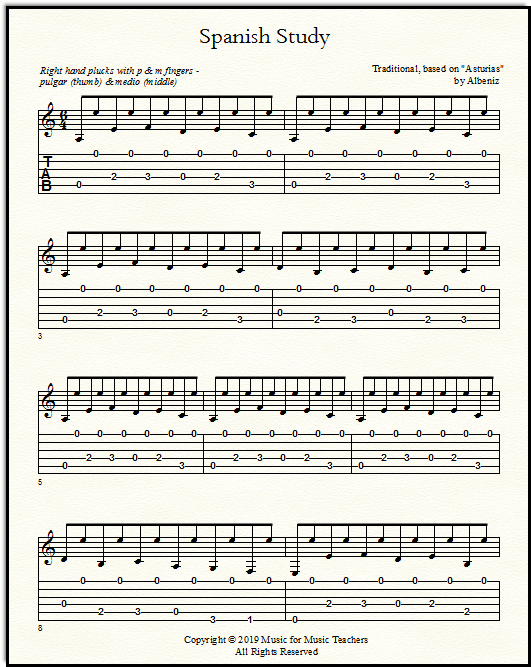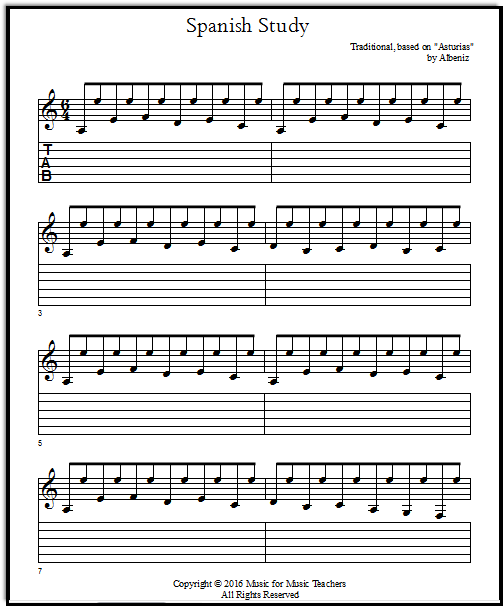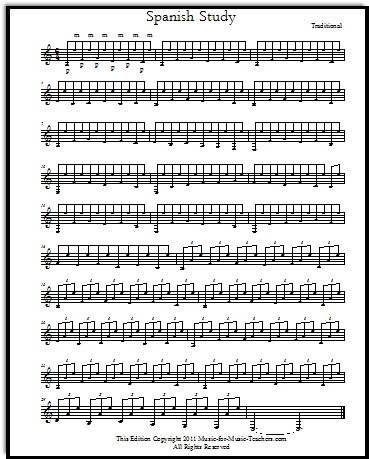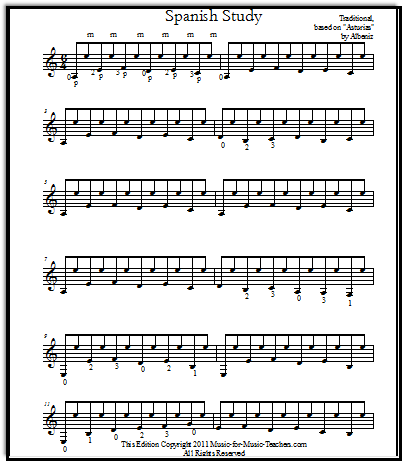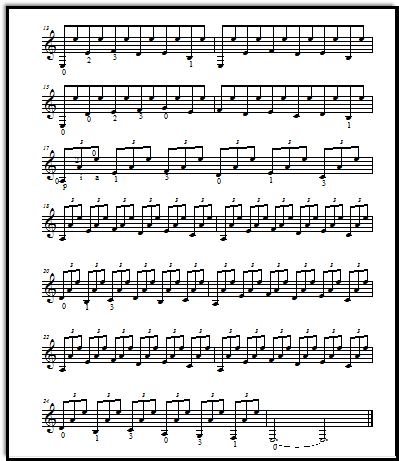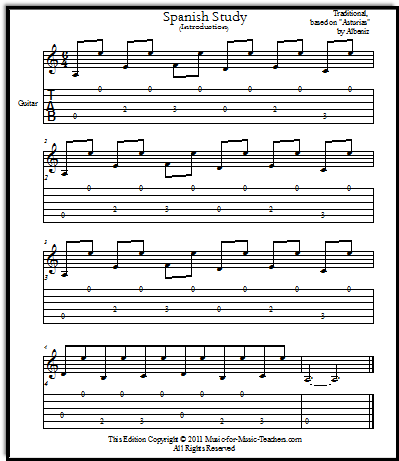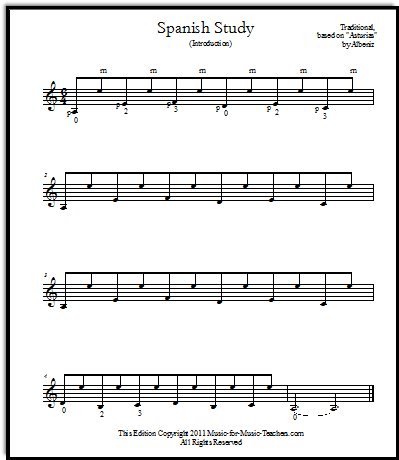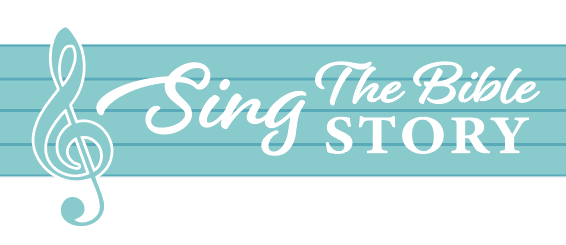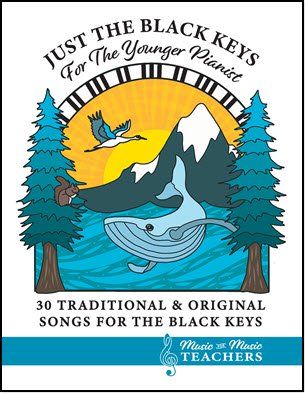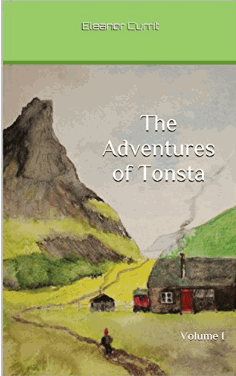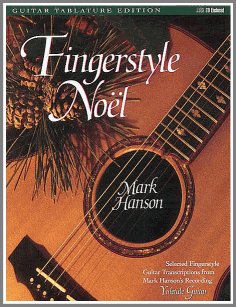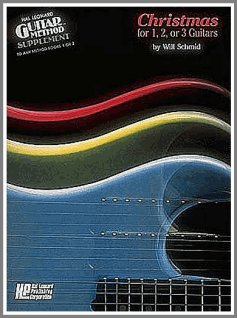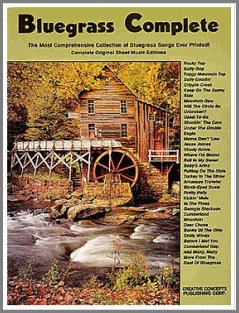Spanish Study
Free Guitar Tabs
Spanish Study - with a new full version with all the tablature.
This piece is based on a very famous classical guitar piece, "Asturias" by Isaac Albeniz.
In spite of being a greatly simplified version of Asturias, even to being set in a different key (the original is high up the neck of the guitar), this piece makes a satisfying and exciting first solo for students wanting to start classical guitar. It sounds more difficult than it really is.
Five versions of Spanish Study
The first arrangement:
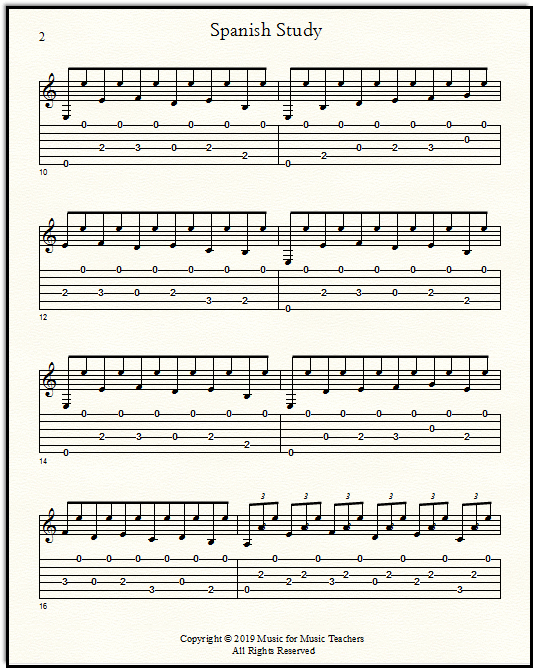
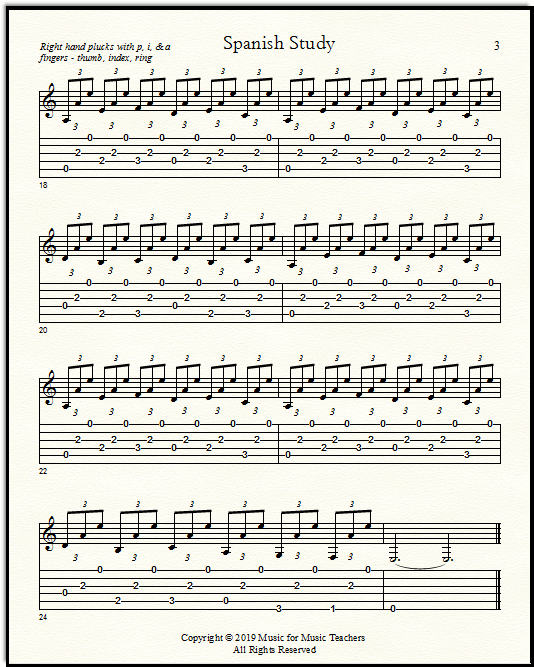
Please scroll down the page for the download links.
This boy plays a shortened version of this piece, much more like what I have offered on this page, with a couple of added chords. Notice how nicely he extends his thumb:
The arrangement below is a study or homework version, so my beginners can figure out the tablature and get more familiar with regular notereading.
How? We compare each note to the tab for it in the Tablature-Staff Note-reading guide, take a pencil, and write it into the empty tablature. See page 1 (three pages altogether).
A version without tablature, page one:
Please scroll down the page for the links to the free PDFs.
The repetition in this piece makes it IDEAL for your guitar students to quickly pick up those treble clef notes!
A version all on one page
Here is a complete version all on one page, with tiny notes and very little in the way of finger markings. It is handy to use once you have the basic idea of the piece:
Please scroll down the page for the download links.
What is "P, I, M, A?"
In classical guitar playing, "p," "i," "m," and "a" stand for the right hand fingers which pluck the strings:
P = pulgar, the thumb
I = indicio, the index finger
M = medio, the middle finger
A = anular, the ring finger
Spanish Study starts with only right hand thumb (p) and middle finger (m), taking turns.
For a correct classical hand position, be sure the thumb plucks off to the side of the hand, so it doesn't meet the fingers. (I recommend purchasing a book such as Frederick Noad's Solo Guitar Playing, which has photographs to help students position their hands and bodies correctly... or find a teacher with a classical background!)
From duplet to triplet rhythm
Notice where the music changes into triplets (the 3-note groups with a "3" over the top of the beam).
The left hand "2" will be placed on "A," the 2nd fret of the "G" string, and stay there for the remainder of the piece.
If you are not familiar with reading staff notation, listen to one of the videos on this page (not Asturias, but Spanish Study, below) and notice where the rhythm changes from a feeling of "1-2, 1-2, 1-2, 1-2, 1-2, 1-2," to a feeling of "1-2-3, 1-2-3, 1-2-3, 1-2-3, 1-2-3, 1-2-3."
Play melody alone
A good way to practice this study is to leave off the high E (string 1) and play the thumb melody alone. This is very helpful for struggling note-readers.
Preparatory to starting this piece, it is a good idea to have your guitar students play short scales on each string, using each fret up to fret 5. Starting at string 6 (Low E), that would sound like:
"Open E, F (fret one), F sharp (fret two), G, G sharp, A. Next string: open A, A sharp, B, C, C sharp, D... Next string: open D, etc."
Make use of a keyboard
I like to do this next to a piano so kids can see that there are no black notes between B and C, and E and F. Otherwise we use a paper keyboard.
Unless they understand that the distance between notes is not always the same, they will always be baffled by note-reading on the guitar.
A version with larger notes & finger markings
The two-page version below is just the same, but it has finger markings on more measures and large notes to make it easy to see!
Be careful not to mistake finger numbers (1, 2, 3) for fret numbers -- sometimes they are the same, but not necessarily!
Notice in measure 9 that the B is fingered with a 1, even though it is a 2nd-fret note; this is to facilitate playing, since the 2nd finger just played an E (and should stay there through the next measure). "0", of course, means open string.
Just before measure 17, the left hand plays the B with a "1" finger again, because in measure 17 finger "2" must quickly snap down on an A.
In the second half of the piece, some of the notes are fingered differently than in the first half, because the "2" finger is busy keeping the "A" note pressed down on the G string for the entire second half.
Keep it pressed down! In measure 20, we meet a B note again, once again fingered with a "1" even though the C in the next fret is fingered with a 3.
Please scroll down the page for the download links.
A very short version, for breaking in
For kids breaking into classical guitar, going "cold turkey" off of tablature may be very scary. I like to help them out with just the first few measures written in tab along with standard notation.
But sometimes, if they have been warming up to standard notation, I give them this version instead:
Please scroll down the page for the download links.
Here is the piece as a lesson on Youtube:
After playing entirely through this lovely piece, you can figure out why it is called a "study" or "etude" - all the right hand fingers get their turn to be part of a pattern, and it is tiring until your hand builds up strength.
Don't overdo it at first! I mean it - you must be cautious with the small muscles of your arms and fingers.
Here is a final version of Asturias, played by guitarist John Williams. He gives an informative introduction and history to this piece:
The links to the guitar music:
Download Spanish Study, three pages of treble clef with guitar tablature
Download worksheet version of Spanish Study with blank tablature
Download Spanish Study all on one page
Download the study on two pages
Download Spanish Study Intro with Tablature
Download the study Intro, no Tab
Dianna:
Your website is a light in the darkness. THANK YOU for all you do in helping to spread the love of music. It matters!
Recent Articles
-
The Snowman Theme Walking In the Air: Lovely Piano Sheet
This sparkling piano arrangement of the main musical theme from The Snowman will win your students' hearts and imaginations, too, with its soaring beauty! -
Moonlight Sonata: How to Play Beethoven's Lovely Piece
Moonlight Sonata: How to play this beautiful but difficult piece full of black keys & triplets? With larger-than-usual notes, & letters inside the note heads! -
Classical Piano Sheet Music: a Set of Introductions
Classical piano sheet music - Fun, mostly one-page intros! Bach, Beethoven, Mozart & more - see what's new! -
Singing In a Round: "Come Away" Has Six Possible Parts!
Singing in a round is a fun challenge for voice students! This pretty song, "Come Away," can be sung with as few as 2 voices, or as many as 6. Free PDFs!! -
How to Teach Voice Lessons for the First-Time Teacher
How to teach voice lessons, when you are a beginning teacher? Get some tips to quell your fears at this new venture! Warmups, rounds, duets, & solos, free!
Interested in songs from the Bible for your students or church? Check out my other website, SingTheBibleStory.com!
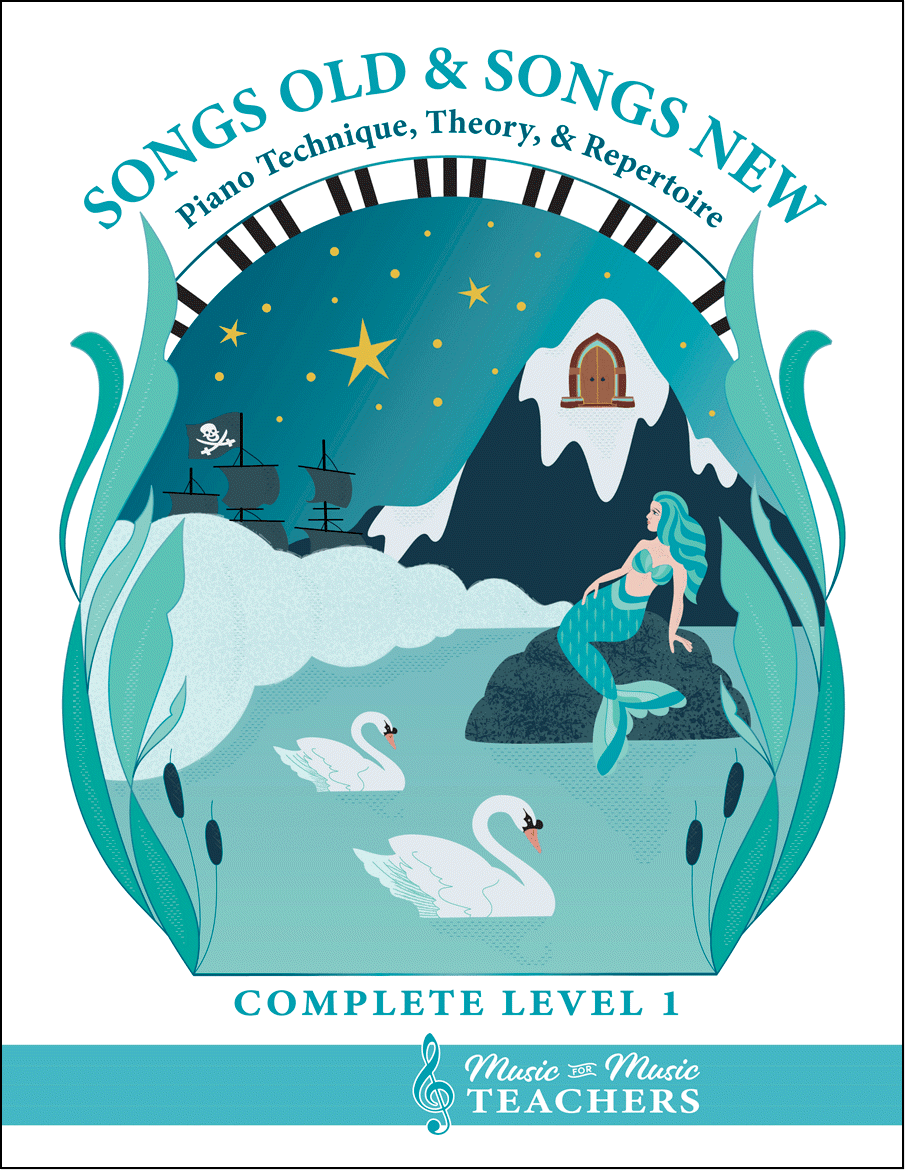
All the first-year material I give my beginner students.
Piano keyboard sheets, scales, chords, note-reading exercises, and over 256 pages of music!
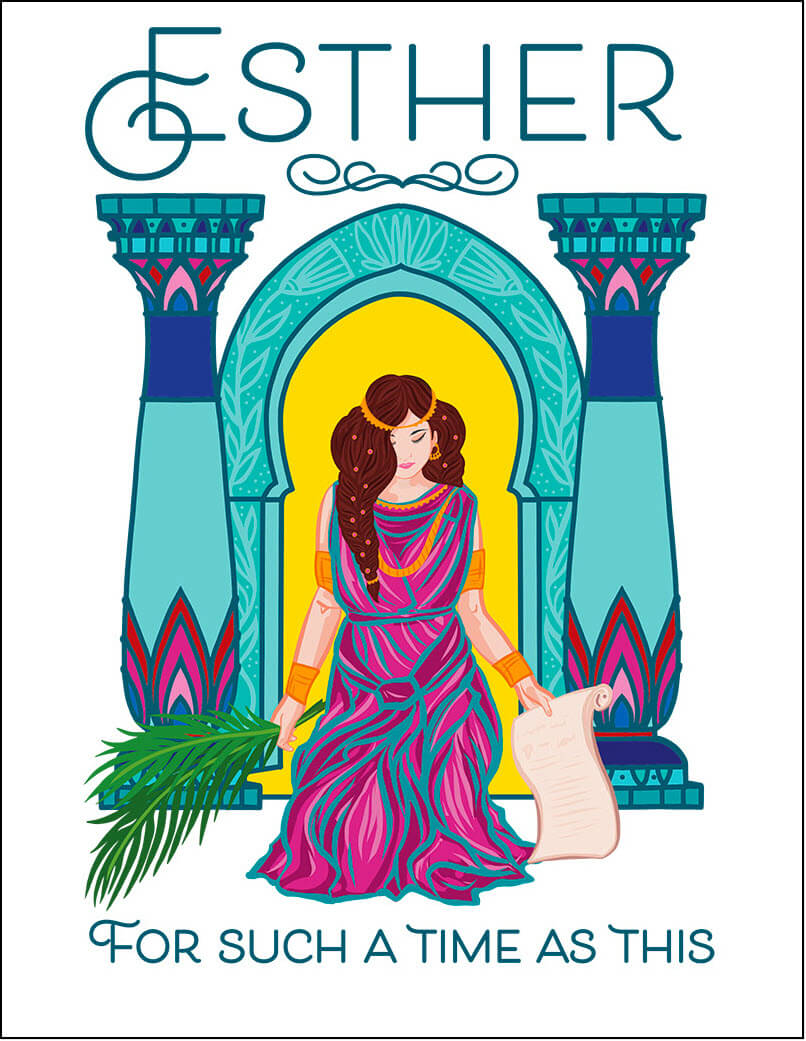
This beautiful song book for piano & voice "Esther, For Such a Time as This", available as a digital download, tells the riveting story of the time when Jews in ancient Persia faced a foe named Haman, and how a brave young queen risked her life to save her people.
A good choice for a singing story-teller, an operatic group, a short theater production, or a class of children!
This book is also available from Amazon as a paperback.
This book is available as a digital download from this site. Visit this page to see some free examples from the book.
It is also available from Amazon as a paperback!
This is the perfect easy start for little pianists.
And when they start reading white-key notes on the staff, this is a fun easy resource to say each week, "Choose a new black-key song at home this week and figure it out to show me next lesson!" They will be spending more time at the piano.
A perfect read aloud storybook
for little boys or girls.
The Adventures of Tonsta highlight the travels of a very young boy with a good heart, who goes about helping folk in trouble.
With a red cap on his head and a sack of tools slung over his shoulder, Tonsta seems to meet people in distress wherever he goes.
Lots of trolls in this book - including one who gives him a Christmas gift!
Lin:
Thank you for a most excellent site. I am a classical guitar teacher, who endeavors to cover chords and fingerstyle as well. I especially liked the printable Celtic music, as some of my teenage students enjoy it! Thank you, again.
Matt:
THIS SITE IS AMAZING!!
I've been teaching guitar for about 5 years now, and I've only just found your website! (I could really have used it 5 years ago) :-)
I teach at primary schools every week day for about 4 hours, so the beginner tabs you have are ideal. Thank you so much for your hard work getting these on the web, you have made many children very happy!!
Comments
Do you have a story or a question about teaching guitar? Do you think it is a hard instrument for beginners, or easy? What have been your challenges?
Please note that all comments are moderated, and will not appear until I have approved them. Also, IF YOU ARE ASKING FOR MUSIC THAT IS NOT IN THE PUBLIC DOMAIN, YOUR REQUEST WILL BE IGNORED. That's pretty much any music written in the last 75 years...
About the Author

Hi, I'm Dana! (Say that like "Anna".) I'm the owner of Music-for-Music-Teachers.com, and a newer site, SingTheBibleStory.com.
Like some of you, I've been playing the piano since early childhood, and have added a few other instruments along the way, plus an interest in arranging and composing music.
You can find out more about me and the reason for this website at my About Me page.
